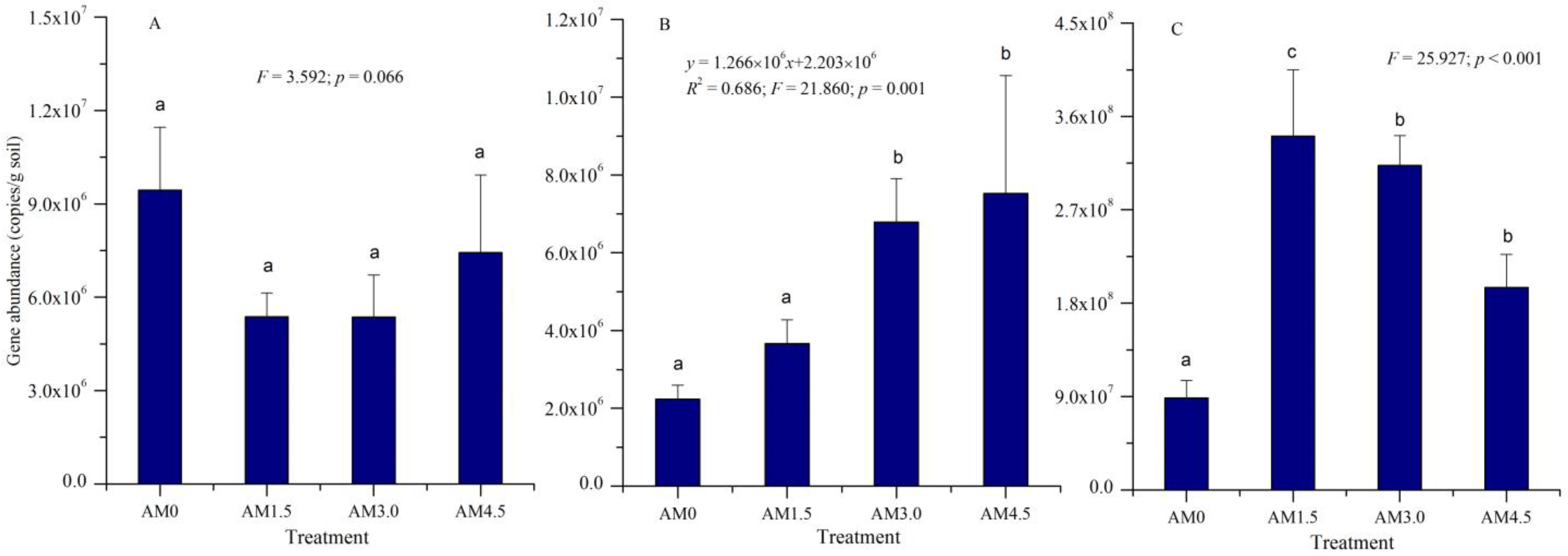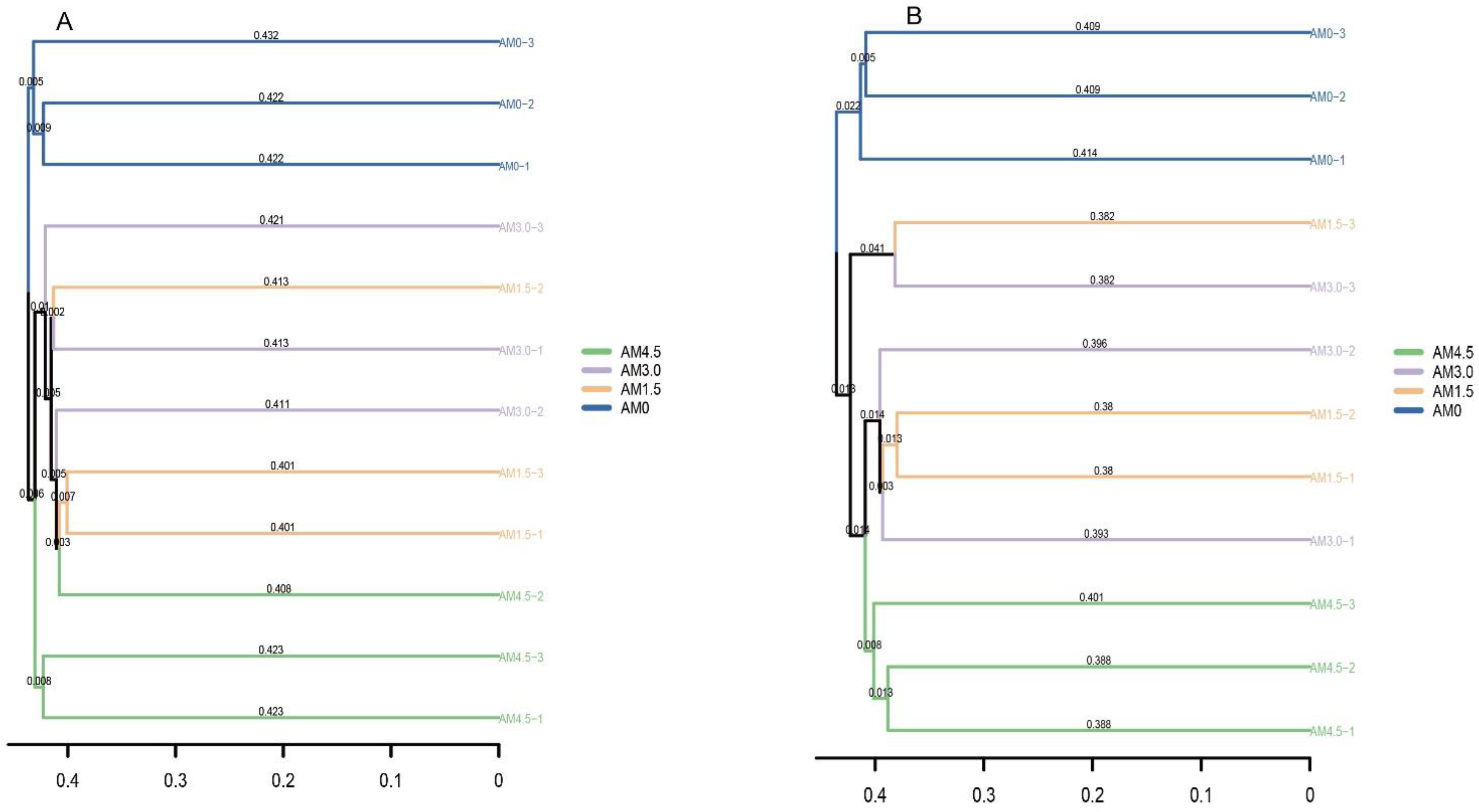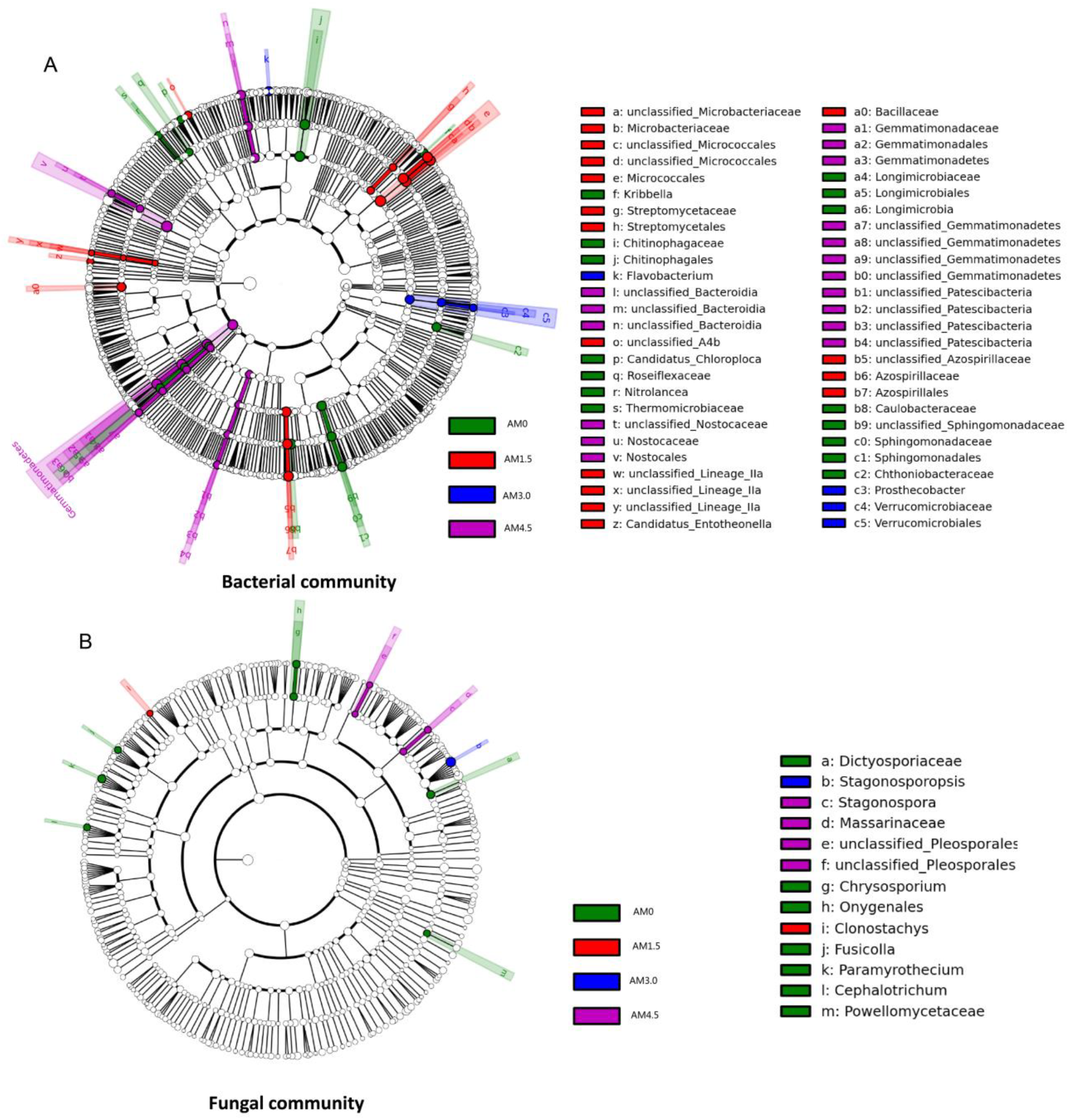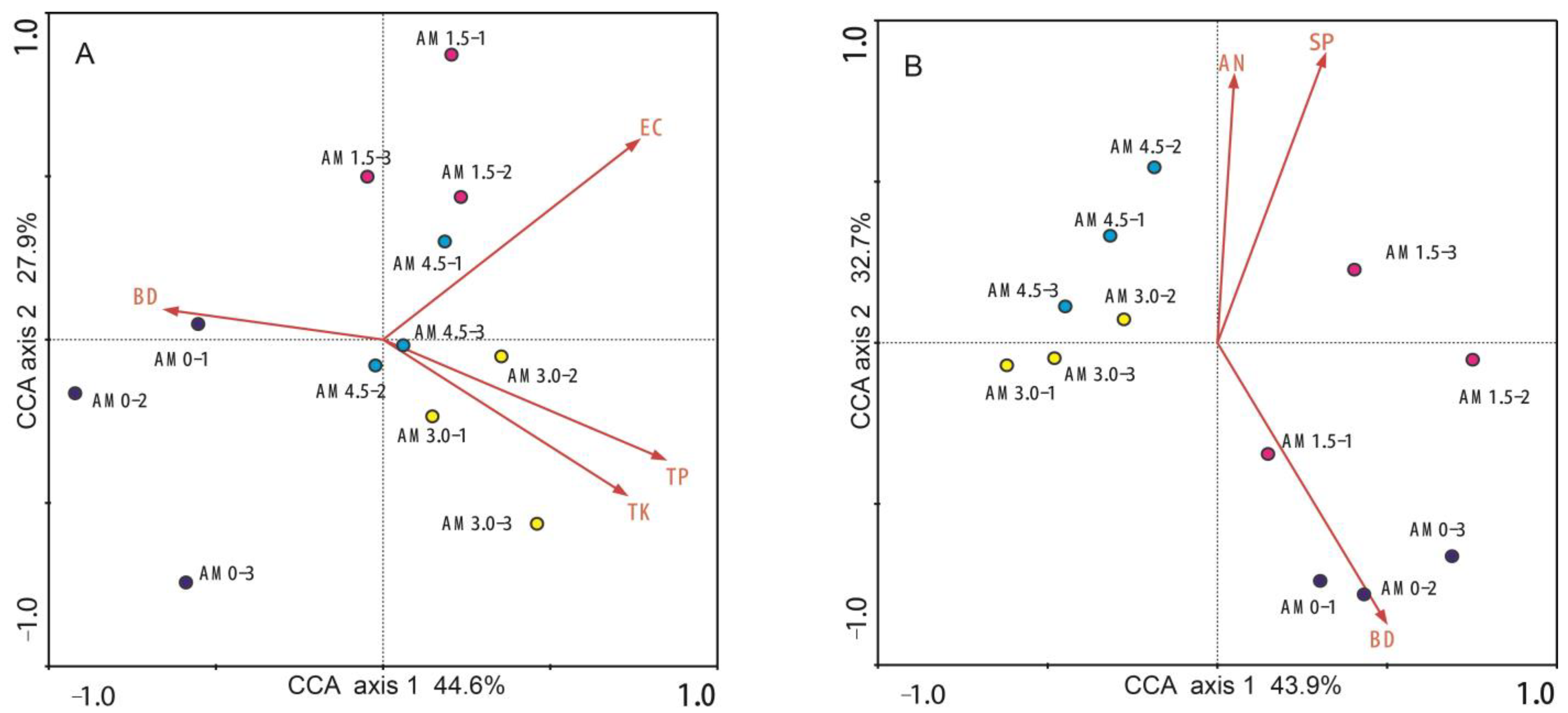Responses of Soil Microbial Communities in an Alkalized Meadow Soil to Biochar Addition
Abstract
1. Introduction
2. Materials and Methods
2.1. Study Location Description
2.2. Experimental Design and Soil Sampling
2.3. Soil Property Determinations
2.4. Soil DNA Extraction, 16S rRNA/ITS Gene Sequencing, and Functional Gene Quantification
2.5. Statistical Analysis
3. Results
3.1. Effects of Biochar Application on Biomass and Soil Properties
3.2. Impact of Biochar Addition on Soil Microbial Activity
3.3. Effects of Biochar Amendment on the Quantities of Functional Microorganisms Involved in N Fixation, Ammonia Oxidation, and P Transformation
3.4. Response of Soil Bacterial Community to Biochar Addition
3.5. Response of Soil Fungal Community to Biochar Addition
3.6. Relationships Between Microbial Community Shifts and Edaphic Properties
4. Discussion
4.1. Effects of Biochar Amendment on Forage Biomass in Alkalized Meadow Soil
4.2. Effects of Biochar Amendment on the Attributes of Alkalized Meadow Soil
4.3. Effects of Biochar Addition on Soil Functional Microbial Abundance
4.4. Effects of Biochar Application on Soil Microbial Community Structure in Alkalized Meadow Soil
5. Conclusions
Author Contributions
Funding
Institutional Review Board Statement
Informed Consent Statement
Data Availability Statement
Acknowledgments
Conflicts of Interest
References
- Tripathi, M.; Sahu, J.N.; Ganesan, P. Effect of process parameters on production of biochar from biomass waste through pyrolysis: A review. Renew. Sust. Energ. Rev. 2016, 55, 467–481. [Google Scholar] [CrossRef]
- Hou, J.X.; Zhang, J.R.; Liu, X.Z.; Ma, Y.Y.; Wei, Z.H.; Wan, H.; Liu, F.L. Effect of biochar addition and reduced irrigation regimes on growth, physiology and water use efficiency of cotton plants under salt stress. Ind. Crop Prod. 2023, 198, 116702. [Google Scholar] [CrossRef]
- Wang, X.L.; Riaz, M.; Babar, S.; Eldesouki, Z.; Liu, B.; Xia, H.; Li, Y.X.; Wang, J.Y.; Xia, X.Y.; Jiang, C.C. Alterations in the composition and metabolite profiles of the saline-alkali soil microbial community through biochar application. J. Environ. Manag. 2024, 352, 120033. [Google Scholar] [CrossRef] [PubMed]
- Sheng, Y.Q.; Zhu, L.Z. Biochar alters microbial community and carbon sequestration potential across different soil pH. Sci. Total Environ. 2018, 622, 1391–1399. [Google Scholar] [CrossRef]
- He, K.; He, G.; Wang, C.P.; Zhang, H.P.; Xu, Y.; Wang, S.M.; Kong, Y.Z.; Zhou, G.K.; Hu, R.B. Biochar amendment ameliorates soil properties and promotes Miscanthus growth in a coastal saline-alkali soil. Appl. Soil Ecol. 2020, 155, 103674. [Google Scholar] [CrossRef]
- Liu, M.; Wang, Z.C.; Yang, F.; Li, J.P.; Liang, Z.W. Application progress of biochar in amelioration of saline-alkaline soil. J. Soil Water Conserv. 2021, 35, 1–8. [Google Scholar] [CrossRef]
- Bolan, S.; Sharma, S.; Mukherjee, S.; Kumar, M.; Rao, C.S.; Nataraj, K.C.; Singh, G.; Vinu, A.; Bhowmik, A.; Sharma, H.; et al. Biochar modulating soil biological health: A review. Sci. Total Environ. 2024, 914, 169585. [Google Scholar] [CrossRef]
- Liu, X.Y.; Liu, C.; Gao, W.H.; Xue, C.; Guo, Z.H.; Jiang, L.; Li, F.; Liu, Y. Impact of biochar amendment on the abundance and structure of diazotrophic community in an alkaline soil. Sci. Total Environ. 2019, 688, 944–951. [Google Scholar] [CrossRef]
- Bhaduri, D.; Saha, A.; Desai, D.; Meena, H.N. Restoration of carbon and microbial activity in salt-induced soil by application of peanut shell biochar during short-term incubation study. Chemosphere 2016, 148, 86–98. [Google Scholar] [CrossRef]
- Shi, Y.L.; Liu, X.R.; Zhang, Q.W.; Li, Y.C. Contrasting effects of biochar- and organic fertilizer-amendment on community compositions of nitrifiers and denitrifiers in a wheat-maize rotation system. Appl. Soil Ecol. 2022, 171, 104320. [Google Scholar] [CrossRef]
- Liu, S.N.; Meng, J.; Jiang, L.L.; Yang, X.; Lan, Y.; Cheng, X.Y.; Chen, W.F. Rice husk biochar impacts soil phosphorous availability, phosphatase activities and bacterial community characteristics in three different soil types. Appl. Soil Ecol. 2017, 116, 12–22. [Google Scholar] [CrossRef]
- Gu, M.Y.; Tang, G.M.; Zhang, Y.S.; Huang, J.; Zhang, Z.D.; Zhang, L.J.; Zhu, J.; Tang, Q.Y.; Chu, M.; Xu, W.L. Effects of organic fertilizers and biochar on microorganism community characteristics in saline-alkali sandy soil of Xinjiang. Ecol. Environ. Sci. 2023, 32, 1392–1404. [Google Scholar]
- Xia, X.Y.; Wang, X.L.; Xia, H.; Li, Y.X.; Wang, J.Y.; Jiang, C.C. Characteristics of modified biochar and its application in improving saline-alkali soil. J. Huazhong Agric. Univ. 2023, 42, 12–19. [Google Scholar]
- Wu, Z.X.; Li, H.H.; Liu, Q.L.; Ye, C.Y.; Yu, F.X. Application of bio-organic fertilizer, not biochar, in degraded red soil improves soil nutrients and plant growth. Rhizosphere 2020, 16, 100264. [Google Scholar] [CrossRef]
- Zhang, P.; Bing, X.; Jiao, L.; Xiao, H.; Li, B.X.; Sun, H.W. Amelioration effects of coastal saline-alkali soil by ball-milled red phosphorus-loaded biochar. Chem. Eng. J. 2022, 431, 133904. [Google Scholar] [CrossRef]
- Godlewska, P.; Ok, Y.S.; Oleszczuk, P. The dark side of black gold: Ecotoxicological aspects of biochar and biochar-amended soils. J. Hazard. Mater. 2021, 403, 123833. [Google Scholar] [CrossRef]
- ISSCAS (Institute of Soil Science, Chinese Academy of Sciences). Physical and Chemical Analysis Methods of Soils; Shanghai Science Technology Press: Shanghai, China, 1978; pp. 7–59. [Google Scholar]
- Xu, G.H.; Zheng, H.Y. Manual of Analytical Methods of Soil Microorganism; China Agriculture Press: Beijing, China, 1986; pp. 266–269. [Google Scholar]
- ISSCAS (Institute of Soil Science, Chinese Academy of Sciences). Methods on Soil Microorganisms Study; Science Press: Beijing, China, 1985; pp. 260–275. [Google Scholar]
- Kandeler, E.; Gerber, H. Short-term assay of soil urease activity using colorimetric determination of ammonium. Biol. Fertil. Soils 1988, 6, 68–72. [Google Scholar] [CrossRef]
- Ladd, J.N.; Butler, J.H.A. Short-term assays of soil proteolytic enzyme activities using proteins and dipeptide derivatives as substrates. Soil Biol. Biochem. 1972, 4, 19–30. [Google Scholar] [CrossRef]
- Schinner, F.; Öhlinger, R.; Kandeler, E.; Margesin, R. Methods in Soil Biology; Springer: Berlin/Heidelberg, Germany, 1996. [Google Scholar]
- Perucci, P.; Casucci, C.; Dumontet, S. An improved method to evaluate the o-diphenol oxidase activity of soil. Soil Biol. Biochem. 2000, 32, 1927–1933. [Google Scholar] [CrossRef]
- Zhao, D.Y.; Luo, J.; Wang, J.Q.; Huang, R.; Guo, K.; Li, Y.; Wu, Q.L.L. The influence of land use on the abundance and diversity of ammonia oxidizers. Curr. Microbiol. 2015, 70, 282–289. [Google Scholar] [CrossRef]
- Poly, F.; Ranjard, L.; Nazaret, S.; Gourbière, F.; Monrozier, L.J. Comparison of nifH gene pools in soils and soil microenvironments with contrasting properties. Appl. Environ. Microb. 2001, 67, 2255–2262. [Google Scholar] [CrossRef] [PubMed]
- Chen, X.D.; Jiang, N.; Condron, L.M.; Dunfield, K.E.; Chen, Z.H.; Wang, J.K.; Chen, L.J. Impact of long-term phosphorus fertilizer inputs on bacterial phoD gene community in a maize field, Northeast China. Sci. Total Environ. 2019, 669, 1011–1018. [Google Scholar] [CrossRef] [PubMed]
- Jin, P.H.; Chen, Z.; Wang, H.; Lv, R.J.; Hu, T.L.; Zhou, R.; Zhang, J.R.; Lin, X.W.; Liu, Q.; Xie, Z.B. 12-year continuous biochar application: Mitigating reactive nitrogen loss in paddy fields but without rice yield enhancement. Agric. Ecosyst. Environ. 2024, 375, 109223. [Google Scholar] [CrossRef]
- Liao, X.; Niu, Y.H.; Liu, D.Y.; Chen, Z.M.; He, T.H.; Luo, J.F.; Lindsey, S.; Ding, W.X. Four-year continuous residual effects of biochar application to a sandy loam soil on crop yield and N2O and NO emissions under maize-wheat rotation. Agric. Ecosyst. Environ. 2020, 302, 107109. [Google Scholar] [CrossRef]
- Luo, L.; Wang, J.X.; Lv, J.T.; Liu, Z.A.; Sun, T.R.; Yang, Y.; Zhu, Y.G. Carbon Sequestration Strategies in Soil Using Biochar: Advances, Challenges, and Opportunities. Environ. Sci. Technol. 2023, 57, 11357–11372. [Google Scholar] [CrossRef]
- Cui, Y.F.; Meng, J.; Wang, Q.X.; Zhang, W.M.; Cheng, X.Y.; Chen, W.F. Effects of straw and biochar addition on soil nitrogen, carbon, and super rice yield in cold waterlogged paddy soils of North China. J. Integr. Agric. 2017, 16, 1064–1074. [Google Scholar] [CrossRef]
- Amini, S.; Ghadiri, H.; Chen, C.G.; Marschner, P. Salt-affected soils, reclamation, carbon dynamics, and biochar: A review. J. Soils Sediments 2016, 16, 939–953. [Google Scholar] [CrossRef]
- Van Zwieten, L.; Kimber, S.; Morris, S.; Chan, K.Y.; Downie, A.; Rust, J.; Joseph, S.; Cowie, A. Effects of biochar from slow pyrolysis of papermill waste on agronomic performance and soil fertility. Plant Soil 2010, 327, 235–246. [Google Scholar] [CrossRef]
- Liu, G.M.; Zhang, X.C.; Wang, X.P.; Shao, H.B.; Yang, J.S.; Wang, X.P. Soil enzymes as indicators of saline soil fertility under various soil amendments. Agric. Ecosyst. Environ. 2017, 237, 274–279. [Google Scholar] [CrossRef]
- Chu, H.Y.; Lin, X.G.; Fujii, T.; Morimoto, S.; Yagi, K.; Hu, J.L.; Zhang, J.B. Soil microbial biomass, dehydrogenase activity, bacterial community structure in response to long-term fertilizer management. Soil Biol. Biochem. 2007, 39, 2971–2976. [Google Scholar] [CrossRef]
- Watanabe, K. Detection of protease genes in field soil applied with liquid livestock feces and speculation on their function and origin. Soil Sci. Plant Nutr. 2009, 55, 42–52. [Google Scholar] [CrossRef][Green Version]
- Gianfreda, L.; Rao, M.A.; Piotrowska, A.; Palumbo, G.; Colombo, C. Soil enzyme activities as affected by anthropogenic alterations: Intensive agricultural practices and organic pollution. Sci. Total Environ. 2005, 341, 265–279. [Google Scholar] [CrossRef] [PubMed]
- Xu, Y.X.; He, L.L.; Liu, Y.X.; Lv, H.H.; Wang, Y.Y.; Chen, J.Y.; Yang, S.M. Effects of biochar addition on enzyme activity and fertility in paddy soil after six years. Chin. J. Appl. Ecol. 2019, 30, 1110–1118. [Google Scholar]
- Lehmann, J.; Rillig, M.C.; Thies, J.; Masiello, C.A.; Hockaday, W.C.; Crowley, D. Biochar effects on soil biota—A review. Soil Biol. Biochem. 2011, 43, 1812–1836. [Google Scholar] [CrossRef]
- Wang, Q.; Geng, Z.C.; Xu, C.Y.; Guo, J.Y.; Li, Q.Q.; Liu, L.L.; Zhao, H.H.; Du, X.G. Effects of biochar application on soil microbial nutrient limitations and carbon use efficiency in Lou soil. Chin. J. Environ. Sci. 2020, 41, 2425–2433. [Google Scholar]
- Feng, J.; Yu, D.; Sinsabaugh, R.L.; Moorhead, D.L.; Andersen, M.N.; Smith, P.; Song, Y.T.; Li, X.Q.; Huang, Q.Y.; Liu, Y.R.; et al. Trade-offs in carbon-degrading enzyme activities limit long-term soil carbon sequestration with biochar addition. Biol. Rev. 2023, 98, 1184–1199. [Google Scholar] [CrossRef]
- Zhang, C.; Zhao, X.; Liang, A.J.; Li, Y.Y.; Song, Q.Y.; Li, X.Y.; Li, D.P.; Hou, N. Insight into the soil aggregate-mediated restoration mechanism of degraded black soil via biochar addition: Emphasizing the driving role of core microbial communities and nutrient cycling. Environ. Res. 2023, 228, 115895. [Google Scholar] [CrossRef]
- Mehmood, I.; Qiao, L.; Chen, H.Q.; Tang, Q.Y.; Woolf, D.; Fan, M.S. Biochar addition leads to more soil organic carbon sequestration under a maize-rice cropping system than continuous flooded rice. Agric. Ecosyst. Environ. 2020, 298, 106965. [Google Scholar] [CrossRef]
- Liu, L.; Ma, Y.L.; Yue, F.X.; Qiao, X.X.; Yin, F.; Wang, Y.F. Effects of biochar on nitrogen transformation functional genes abundances, arbuscular mycorrhizal fungi and N2O emission of rainfed maize season in cinnamon soil. Acta Ecol. Sin. 2021, 41, 2803–2815. [Google Scholar]
- Li, S.L.; Wang, S.; Shangguan, Z.P. Combined biochar and nitrogen fertilization at appropriate rates could balance the leaching and availability of soil inorganic nitrogen. Agric. Ecosyst. Environ. 2019, 276, 21–30. [Google Scholar] [CrossRef]
- Zhang, Y.; Yang, C.D.; Wang, J.; Lu, S.G. Biochar co-applied with lime enhances soil phosphorus availability via microbial and enzymatic modulation of paddy soil. Microorganisms 2025, 13, 582. [Google Scholar] [CrossRef] [PubMed]
- Yuan, Q.S.; Gao, Y.; Ma, G.Z.; Wu, H.Z.; Li, Q.S.; Zhang, Y.L.; Liu, S.L.; Jie, X.L.; Zhang, D.X.; Wang, D.C. The long-term effect of biochar amendment on doil biochemistry and phosphorus availability of calcareous soils. Agriculture 2025, 15, 458. [Google Scholar] [CrossRef]
- Liu, J.J.; Sui, Y.Y.; Yu, Z.H.; Shi, Y.; Chu, H.Y.; Jin, J.; Liu, X.B.; Wang, G.H. High throughput sequencing analysis of biogeographical distribution of bacterial communities in the black soils of northeast China. Soil Biol. Biochem. 2014, 70, 113–122. [Google Scholar] [CrossRef]
- Yang, J.J.; Li, W.J.; Teng, D.X.; Yang, X.D.; Zhang, Y.J.; Li, Y. Metagenomic insights into microbial community structure, function, and salt adaptation in saline soils of arid land, China. Microorganisms 2022, 10, 2183. [Google Scholar] [CrossRef]
- Li, X.; Romanyà, J.; Li, N.; Xiang, Y.S.; Yang, J.F.; Han, X.R. Biochar fertilization effects on soil bacterial community and soil phosphorus forms depends on the application rate. Sci. Total Environ. 2022, 843, 157022. [Google Scholar] [CrossRef] [PubMed]
- Bergey, D.H.; Whitman, W.B. Bergey’s Manual of Systematics of Archaea and Bacteria; John Wiley & Sons, Inc. Press: Hoboken, NJ, USA, 2015. [Google Scholar]
- Liu, L.; Liu, Y.; Zhang, P.; Song, G.; Hui, R.; Wang, Z.; Wang, J. Development of bacterial communities in biological soil crusts along a revegetation chronosequence in the Tengger Desert, Northwest China. Biogeosciences 2017, 14, 3801–3814. [Google Scholar] [CrossRef]
- Huber, K.J.; Overmann, J. Vicinamibacteraceae fam. nov., the first described family within the subdivision 6 Acidobacteria. Int. J. Syst. Evol. Micr. 2018, 68, 2331–2334. [Google Scholar] [CrossRef]
- Etemadi-Khah, A.; Pourbabaee, A.A.; Alikhani, H.A.; Noroozi, M.; Bruno, L. Biodiversity of isolated Cyanobacteria from desert soils in Iran. Geomicrobiol. J. 2017, 34, 784–794. [Google Scholar] [CrossRef]
- Li, Y.Y.; Pan, F.X.; Yao, H.Y. Response of symbiotic and asymbiotic nitrogen-fixing microorganisms to nitrogen fertilizer application. J. Soils Sediments 2019, 19, 1948–1958. [Google Scholar] [CrossRef]
- Yao, Q.; Liu, J.J.; Yu, Z.H.; Li, Y.S.; Jin, J.; Liu, X.B.; Wang, G.H. Three years of biochar amendment alters soil physiochemical properties and fungal community composition in a black soil of northeast China. Soil Biol. Biochem. 2017, 110, 56–67. [Google Scholar] [CrossRef]
- Tedersoo, L.; Bahram, M.; Polme, S.; Koljalg, U.; Yorou, N.S.; Wijesundera, R.; Ruiz, L.V.; Vasco-Palacios, A.M.; Thu, P.Q.; Suija, A.; et al. Global diversity and geography of soil fungi. Science 2014, 346, 1078. [Google Scholar] [CrossRef] [PubMed]
- Larghi, E.L.; Kaufman, T.S. Cheminform abstract: Isolation, synthesis and complement inhibiting activity of the naturally occurring K-76, its analogues and derivatives. Arkivoc 2011, 42, 49. [Google Scholar] [CrossRef]
- Khatami, S.; Deng, Y.; Tien, M.; Hatcher, P.G. Lignin contribution to aliphatic constituents of humic acids through fungal degradation. J. Environ. Qual. 2019, 48, 1565–1570. [Google Scholar] [CrossRef]
- Zhao, Y.X.; Zhang, T.; Zhao, Y.X.; Hua, D.L.; Yu, H.L. Effect of Penicillium on the degradation of straw by compound bacterium agent. Renew. Energy Resour. 2022, 40, 285–291. [Google Scholar] [CrossRef]
- Yang, S.; Yang, T.; Lin, B.; Liu, X.Z.; Xiang, M.C. Isolation and evaluation of two phosphate-dissolving fungi. Acta Microbiol. Sin. 2018, 58, 264–273. [Google Scholar] [CrossRef]
- Wang, C.; Chen, D.; Shen, J.L.; Yuan, Q.; Fan, F.L.; Wei, W.X.; Li, Y.; Wu, J.S. Biochar alters soil microbial communities and potential functions 3-4 years after amendment in a double rice cropping system. Agric. Ecosyst. Environ. 2021, 311, 107291. [Google Scholar] [CrossRef]
- Mahapatra, S.; Rao, E.S.; Sandeepkumar, G.M.; Sriram, S. Stagonosporopsis cucurbitacearum the causal agent of gummy stem blight of watermelon in India. Australas. Plant Dis. Notes 2020, 15, 7. [Google Scholar] [CrossRef]





| Year | AM0 | AM1.5 | AM3.0 | AM4.5 | ANOVA in Response to Biochar Application Rate | |||
|---|---|---|---|---|---|---|---|---|
| Regression Equation | R2 | F | p | |||||
| 1 | 0.31 ± 0.02a | 0.38 ± 0.03a | 0.48 ± 0.03b | 0.44 ± 0.02b | y = 0.064x + 0.656 | 0.714 | 24.906 | <0.001 |
| 2 | 0.34 ± 0.09a | 0.88 ± 0.05c | 0.55 ± 0.08b | 0.27 ± 0.06a | - | 0.052 | 0.548 | 0.476 |
| Index | AM0 | AM1.5 | AM3.0 | AM4.5 | ANOVA in Response to Application Rate | ||
|---|---|---|---|---|---|---|---|
| R2 | F | p | |||||
| Soil moisture (%) | 6.37 ± 1.05a | 9.05 ± 1.14ab | 10.77 ± 1.26b | 11.22 ± 2.06b | 0.664 | 19.762 | <0.001 |
| pH | 8.00 ± 0.02a | 8.17 ± 0.04a | 8.08 ± 0.07a | 8.13 ± 0.04a | 0.213 | 2.704 | 0.131 |
| Organic matter (%) | 1.19 ± 0.98a | 1.77 ± 0.15ab | 2.10 ± 0.57ab | 2.31 ± 0.58c | 0.579 | 13.755 | 0.004 |
| Soil porosity (%) | 39.50 ± 1.79a | 42.64 ± 2.29b | 45.66 ± 1.31c | 46.42 ± 0.38c | 0.768 | 33.196 | <0.001 |
| Bulk density (g cm−3) | 1.60 ± 0.05c | 1.52 ± 0.06b | 1.44 ± 0.35ab | 1.42 ± 0.01a | 0.768 | 33.155 | <0.001 |
| Field water holding capacity (%) | 12.33 ± 2.07a | 14.35 ± 1.10b | 15.43 ± 2.85bc | 16.44 ± 2.27c | 0.413 | 7.030 | 0.024 |
| Electrical conductivity (μs cm−1) | 106.1 ± 8.17a | 150.2 ± 7.87b | 140.2 ± 6.15b | 141.8 ± 4.85b | 0.372 | 5.928 | 0.035 |
| Total N (%) | 0.029 ± 0.00a | 0.042 ± 0.002b | 0.044 ± 0.01b | 0.049 ± 0.002b | 0.705 | 23.906 | <0.001 |
| Total P (%) | 0.02 ± 0.01a | 0.03 ± 0.00a | 0.04 ± 0.02a | 0.04 ± 0.01a | 0.283 | 3.940 | 0.075 |
| Total K (%) | 2.20 ± 0.01a | 2.24 ± 0.52a | 2.31 ± 0.08a | 2.24 ± 0.02a | 0.122 | 1.385 | 0.266 |
| NH4-N (mg kg−1) | 0.61 ± 0.04a | 0.68 ± 0.05ab | 0.67 ± 0.03ab | 0.75 ± 0.01c | 0.640 | 17.751 | 0.002 |
| Available P (mg kg−1) | 15.77 ± 0.18a | 26.85 ± 3.18b | 38.42 ± 6.03c | 42.93 ± 5.63c | 0.868 | 96.818 | <0.001 |
| Available K (mg kg−1) | 147.6 ± 6.91a | 221.4 ± 9.90b | 205.0 ± 18.76b | 216.0 ± 3.96b | 0.468 | 8.811 | 0.014 |
| Index | AM0 | AM1.5 | AM3.0 | AM4.5 | ANOVA in Response to Application Rate | ||
|---|---|---|---|---|---|---|---|
| R2 | F | p | |||||
| Dehydrogenase (mg TPF kg−1 24 h−1) | 192.0 ±19.46c | 190.4 ± 22.69c | 166.6 ± 6.25b | 139.7 ± 36.11a | 0.494 | 9.773 | 0.011 |
| Protease (mg Tyr g−1 2 h−1) | 75.33 ± 10.41a | 107.6 ± 18.24c | 88.51 ± 8.70b | 92.59 ± 16.98b | 0.050 | 0.528 | 0.484 |
| Urease (mg 100 g−1 24 h−1) | 6.30 ± 0.69a | 18.66 ± 3.38c | 14.37 ± 4.65b | 14.82 ± 2.59b | 0.209 | 2.648 | 0.135 |
| Polyphenol oxidase (µmol g−1 10 min−1) | 0.686 ± 0.22a | 3.31 ± 0.36c | 4.6 ± 0.47d | 2.70 ± 0.03b | 0.338 | 5.104 | 0.047 |
| Phosphomonoesterase (mg g−1 h−1) | 76.27 ± 6.43a | 118.7 ± 14.01c | 97.80 ± 19.71b | 85.87 ± 15.46b | 0.002 | 0.020 | 0.891 |
| Glucosidase (μg g−1 h−1) | 1.17 ± 0.21b | 0.74 ± 0.22b | 0.54 ± 0.18a | 0.54 ± 0.18a | 0.722 | 25.96 | <0.001 |
Disclaimer/Publisher’s Note: The statements, opinions and data contained in all publications are solely those of the individual author(s) and contributor(s) and not of MDPI and/or the editor(s). MDPI and/or the editor(s) disclaim responsibility for any injury to people or property resulting from any ideas, methods, instructions or products referred to in the content. |
© 2025 by the authors. Licensee MDPI, Basel, Switzerland. This article is an open access article distributed under the terms and conditions of the Creative Commons Attribution (CC BY) license (https://creativecommons.org/licenses/by/4.0/).
Share and Cite
Gao, T.; Zhang, Y.; Cui, Z.; Cao, C. Responses of Soil Microbial Communities in an Alkalized Meadow Soil to Biochar Addition. Microorganisms 2025, 13, 1228. https://doi.org/10.3390/microorganisms13061228
Gao T, Zhang Y, Cui Z, Cao C. Responses of Soil Microbial Communities in an Alkalized Meadow Soil to Biochar Addition. Microorganisms. 2025; 13(6):1228. https://doi.org/10.3390/microorganisms13061228
Chicago/Turabian StyleGao, Tingting, Ying Zhang, Zhenbo Cui, and Chengyou Cao. 2025. "Responses of Soil Microbial Communities in an Alkalized Meadow Soil to Biochar Addition" Microorganisms 13, no. 6: 1228. https://doi.org/10.3390/microorganisms13061228
APA StyleGao, T., Zhang, Y., Cui, Z., & Cao, C. (2025). Responses of Soil Microbial Communities in an Alkalized Meadow Soil to Biochar Addition. Microorganisms, 13(6), 1228. https://doi.org/10.3390/microorganisms13061228






